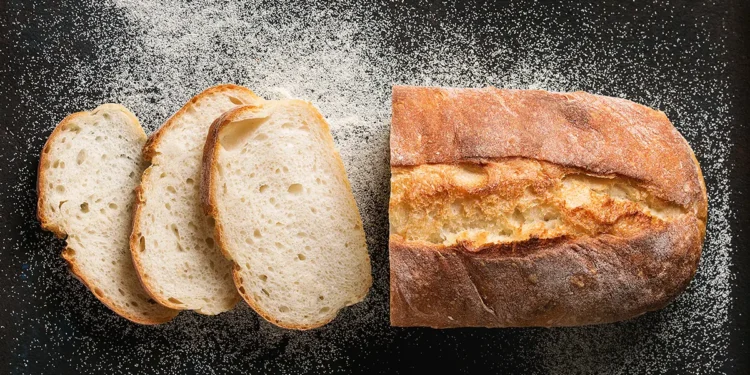From perfect baguette batons that sell out by lunch, to sourdough loaves baked from decades-old starters, fresh bread has never been so enticing, nor so readily available.
The Fresh Bread-Loving Nation of Britain
We are, after all, a nation of bread lovers, with 99.8% of British households succumbing to its floury allure – that’s the equivalent of nearly 11 million loaves a day, including a variety of artisan bread.
Even the popularity of carb-eschewing diets, such as Atkins or Paleo, cannot vex this billion-pound industry; though heightened awareness over health issues and a continued drive towards sustainability in what we consume has allowed for an exciting shift back towards using yeast for authentic bread.
- DUAL TEMPERATURE SENSORS: This breadmaker has two built-in sensors to determine both internal and external temperatures to optimise each programme at every step, giving you the best bread quality possible.
- ARTISAN-STYLE KNEADING: This automatic breadmaker comes equipped with an innovative kneading blade with specially placed ribs in the bread pan to replicate artisan kneading and serve you the best-tasting bread with the ideal texture, every time.
- FULLY AUTOMATIC: This premium breadmaker features both yeast and raisin/nut dispensers, which automatically add the ingredients at the right time, giving you consistently tasty bread with less work.
- AUTOMATIC AND MANUAL SETTINGS: This breadmaker offers up to 32 automatic programmes to choose from for easy baking flexibility, including whole wheat, sourdough and brioche, as well as cake, pizza dough and jam. Simply use the bread mix of your choice, add water and voila! Manual settings let you be creative with your own delicious recipes.
- GOURMET GLUTEN-FREE BAKING: This versatile breadmaker gives you the option of four easy-to-use automatic programmes for delicious gluten-free bread, cake, pizza dough and pasta.
A Visual and Sensory Delight
Those rustic baguettes that are different lengths and sizes with their unique crusts and crevices; hard, round loaves of sourdough which open up to reveal a tangy and impossibly light interior; dark slices of nutty Scandinavian ryes that beg for smoked fish and horseradish; and soft, oily focaccia bejewelled with black olives. This is the kind of bread whose leavening process is vulnerable to changes in weather; the kind that sells out by lunchtime; the kind that makes you happily weak at the knees, but also desperately disappointed when you get to it a day late.
Fresh Bread in History and Culture
Such affection for the humble loaf is not surprising when you consider mankind’s illustrious history with bread, from ancient grains to modern homemade bread recipes. Recent findings suggest that humans processed and consumed wild cereal grains as far back as the Upper Palaeolithic period, laying the groundwork for future bread recipes. During the intervening 23,000 years bread has played an important role, not just in the dietary sense, but also the societal. In ancient Egypt, bread was not only used as a currency but was also offered up to the gods. The Romans founded a guild of bakers, and in Ancient Greece, the bread makers were held in the highest esteem, often using a diverse array of bread recipes.

The Modern Shift: Chorleywood Bread Process
Yet in the 1960s, a huge cultural shift in bread occurred, inspired by a small corner of Hertfordshire, where new bread recipes began to emerge. The Chorleywood Breadmaking Process sated society’s desire for the one thing bread couldn’t offer – convenience and longevity. Devised in 1961 by the British Baking Industries Research Association, the CBP created loaves that stayed fresh for far longer than any traditional crust would, revolutionising the way we think about bread. This was done by mixing more vigorously and mechanically developing the dough, with enzymes enabling it to hold more gas, thus making the bread lighter and softer. Those steps reduced the need for fermentation, meaning time saved and costs minimised, with the resulting loaf better in the sense of its volume, colour, and keeping qualities, akin to a well-crafted artisan bread.
Returning to Tradition
Yet while this cheap and cheerful staple arguably has many positive qualities, it is also far from natural, a pale reflection of the artisan breadmakers of centuries past and, it is speculated, perhaps even partly responsible for the upsurge in food allergies resulting out of highly processed foods.
And so it is that we now find ourselves inexplicably pulled back to the allures of traditional breadmaking, where the use of high-quality bread flour is essential. Masterclasses on how to bake your own lovely loaves are popping up all over the county; bakeries find their shelves brimming in the mornings and empty by early afternoon; and sourdough starters are cherished as much as children and nurtured with the same love and care.
- Hardcover Book
- Leo, Maurizio (Author)
- English (Publication Language)
- 400 Pages – 11/08/2022 (Publication Date) – Random House Inc (Publisher)
Fresh Bread’s Place in the Fast-Paced Modern Life
This ‘rebirth’ leads us to the point where many of us may have never pondered over bread to any real extent, but perhaps are beginning to appreciate the art of kneading dough. For in an age when everything is moving so fast it is those precious moments of pleasure, the morning coffee for example, with hot toast and cold butter, which make day-to-day life bearable.
And those instants not only deserve our full attention; they deserve the good coffee and whether your preference is baguette, challah, ciabatta, farmhouse, focaccia, rye, sourdough, wholemeal or something else besides – the very, very good bread.
Read This Magazine participates in the Amazon Services LLC Associates Program, an affiliate advertising program designed to provide a means for sites to earn advertising fees by advertising and linking to Amazon.com.










